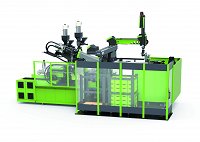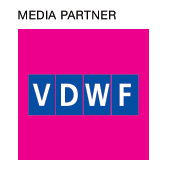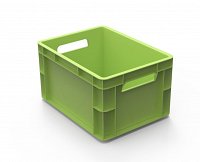Sandwiches with even more recycled content
09.10.2019
Sandwich-moulded components with a core of processed plastics scrap are playing an important role in advancing the circular economy. ENGEL skinmelt makes it possible to achieve high recycled content levels, even when working with complex component geometries. ENGEL will be demonstrating how highly efficient production is possible at the same time at the K 2019 trade fair in Düsseldorf, Germany, between October 16th and 23rd.
Transport boxes will be produced using the new ENGEL skinmelt process at the company’s stand. “The transport boxes are particularly challenging for sandwich injection moulding due to their geometry,” explains Dr. Georg Steinbichler, senior vice president of research and development for technologies at ENGEL AUSTRIA. “But we are still able to reach a high level of recycled content: over 50 %.” Both the recycled and virgin material are polypropylene, ensuring that the sandwich-moulded products can also be easily recycled at the end of their service life.
Space-saving system design
Unlike classic coinjection, the skinmelt process involves fusing the two melts prior to injection. The skin – the virgin material – is first to reach the cavity. It is pushed forward by the inflowing recycled PP and pressed against the cavity walls, while the core is filled with recycled material. The amount of recycled material possible to accumulate in the core depends crucially on the geometry of the moulded part and the flow pattern in the cavity. The injection position chosen and the relative viscosity of the skin and core materials have a significant influence on this outcome.
Excellent reproducibility in the moulding process is necessary to also ensure dimensional reliability and stability in products with a high level of recycled content. For this purpose, ENGEL has engineered an especially compact production solution based on a duo dual-platen injection moulding machine. On the duo 3660H/1560W/450 combi exhibited at K, the second plasticising unit for the skin material is located at a sharp angle above the horizontal injection unit inside which the recycled material is melted – a highly space-saving design. Other stand-out features of the ENGEL solution are its easy-to-use visual display and the animation of the entire process on the injection moulding machine’s CC300 control unit. As a result, it is extremely easy to set the mixing ratio to achieve the ideal recycled content level.
Recycled material from post-consumer sources
 ENGEL is teaming up with partner companies to make this exhibit a reality. The mould is sourced from Haidlmair, an Austrian firm specialising in manufacturing moulds for the production of storage and logistics containers, which will use the transport boxes produced at the K show for its own in-house logistics. As far as the recycled material, ENGEL is working with the German Green Dot company (DSD; Der Grüne Punkt – Duales System Deutschland). DSD has set standards that are recognised industry-wide to facilitate the recovery of raw materials from post-consumer sources. DSD’s PP regrind, produced under the Systalen brand, originates from household refuse that is collected in the yellow bin bags and bins used to dispose of lightweight recyclable packaging, before being sorted and processed in separate categories. “Making much wider use of recycled material is exactly what is needed to keep plastics in a closed loop system,” Georg Steinbichler stresses.
ENGEL is teaming up with partner companies to make this exhibit a reality. The mould is sourced from Haidlmair, an Austrian firm specialising in manufacturing moulds for the production of storage and logistics containers, which will use the transport boxes produced at the K show for its own in-house logistics. As far as the recycled material, ENGEL is working with the German Green Dot company (DSD; Der Grüne Punkt – Duales System Deutschland). DSD has set standards that are recognised industry-wide to facilitate the recovery of raw materials from post-consumer sources. DSD’s PP regrind, produced under the Systalen brand, originates from household refuse that is collected in the yellow bin bags and bins used to dispose of lightweight recyclable packaging, before being sorted and processed in separate categories. “Making much wider use of recycled material is exactly what is needed to keep plastics in a closed loop system,” Georg Steinbichler stresses.
For more information click here





































